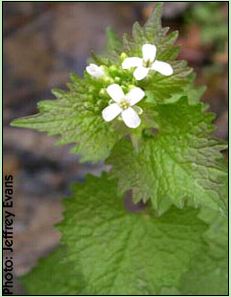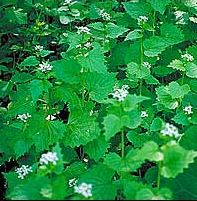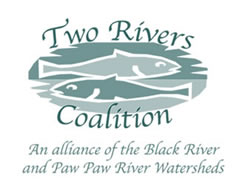Home>Our Work>Community Education>Garlic Mustard
Garlic Mustard - A Major Threat To Our Woodlands
 Garlic mustard (Alliaria petiolata) is an exotic invasive plant from Europe that invades woodland habitats in North America and impacts forest biodiversity. In some woodlands, dense stands of garlic mustard in the spring threaten showy spring blooming ephemerals like spring beauty, trilliums and trout lilies. Other research points toward potentially negative impacts on timber species and forest health. Many land managers consider it to be one of the most potentially harmful and difficult to control invasive plants in the region.
Garlic mustard (Alliaria petiolata) is an exotic invasive plant from Europe that invades woodland habitats in North America and impacts forest biodiversity. In some woodlands, dense stands of garlic mustard in the spring threaten showy spring blooming ephemerals like spring beauty, trilliums and trout lilies. Other research points toward potentially negative impacts on timber species and forest health. Many land managers consider it to be one of the most potentially harmful and difficult to control invasive plants in the region.
Description:
- Appearance: Biennial herbaceous plant with weak single stems 12 - 36" high in its second and flowering year. Only plant of this height blooming white in wooded environments in May.
- Leaves: Round, scallop-edged, dark green; first year, rosettes of 3 or 4 leaves; second year plants have alternate stem leaves. Leaves and stems smell like onion or garlic when crushed.
- Flowers: White, small and numerous, with four separate petals. Each plant has one or two flowering stems on second year plants.
- Seeds: Slender capsules 1-2 1⁄2" long, containing a single row of oblong black seeds. Seeds are viable in the soil for 5 years.
- Roots: White, slender taproot, "S"-shaped at the top.
Ecological Threat:
- Garlic mustard spreads into high quality woodlands upland and floodplain forests, not just into disturbed areas.
- Invaded sites undergo a decline on native herbaceous cover within 10 years.
- Garlic mustard alters habitat suitability for native insects and thereby birds and mammals.
- This European exotic occurs now in 27 midwestern and northeastern states and in Canada.
Control Methods:

Mechanical: Pulling in areas of light infestations. Flowering stem cutting at ground level. Prescribed burning if there is enough fuel to carry the flames.
Chemical: Spot application of 2% glyphosate in early spring or late fall when native plants are dormant.
Informational Brochure: Garlic Mustard (Alliaria petiolata)

